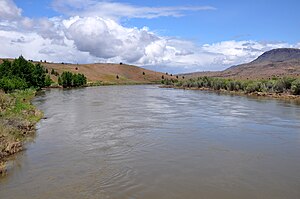John Day River
| John Day River | |
|
John Day River at Clarno
|
|
| Name origin: John Day, a hunter and fur trapper | |
| Country | United States |
|---|---|
| State | Oregon |
| Tributaries | |
| - left | South Fork John Day River |
| - right | North Fork John Day River |
| Source | Strawberry Mountains |
| - location | Malheur National Forest, Grant County |
| - elevation | 6,681 ft (2,036 m) |
| - coordinates | 44°14′44″N 118°33′08″W / 44.245439°N 118.5521617°W |
| Mouth | Columbia River |
| - elevation | 268 ft (82 m) |
| - coordinates | 45°43′57″N 120°38′57″W / 45.7326252°N 120.6492244°WCoordinates: 45°43′57″N 120°38′57″W / 45.7326252°N 120.6492244°W |
| Length | 284 mi (457 km) |
| Basin | 8,000 sq mi (20,720 km2) |
| Discharge | for USGS gage 14048000, McDonald Ferry, river mile 20.9, 45°35′16″N 120°24′30″W / 45.587778°N 120.408333°W |
| - average | 2,075 cu ft/s (59 m3/s) |
| - max | 43,300 cu ft/s (1,226 m3/s) |
| - min | 0 cu ft/s (0 m3/s) |
|
Map of the John Day watershed
|
|
The John Day River is a tributary of the Columbia River, approximately 284 miles (457 km) long, in northeastern Oregon in the United States. Undammed along its entire length, the river is the third longest free-flowing river in the contiguous United States. There is extensive use of its waters for irrigation. Its course furnishes habitat for diverse species, including wild steelhead and Chinook salmon runs. However, the steelhead populations are under federal Endangered Species Act (ESA) protections, and the Chinook salmon have been proposed for such protection.
The river was named for John Day, a member of the Pacific Fur Company's overland expedition to the mouth of the Columbia River that left Missouri in 1810. Day struggled through eastern Oregon during the winter of 1811–12. While descending the Columbia River in April 1812, he and Ramsay Crooks were robbed and stripped naked by Native Americans at the mouth of the river that now bears his name, forcing them to hike 80 miles (130 km) back to friendly Umatilla Indians under extreme conditions.
The absence of dams on the river causes its flow to greatly fluctuate throughout the year depending on snowpack and rainfall within the watershed. The highest flow recorded at a gauge on the lower John Day was 43,300 cubic feet per second (1,230 m3/s) on January 2, 1997. The lowest flow was no flow at all, which occurred on September 2, 1966; from August 15 to September 16, 1973; and on nine days in August 1977. The average flow at the gauge is 2,075 cubic feet per second (58.8 m3/s).
Through its tributaries, the river drains much of the western side of the Blue Mountains, flowing across the sparsely populated arid part of the state east of the Cascade Range in a northwest zigzag, then entering the Columbia upstream from the Columbia River Gorge. It flows through exceptionally scenic canyons in its upper course, with several significant paleontological sites along its banks. Elevations within the watershed range from 268 feet (82 m) at the river's mouth to more than 9,000 feet (2,700 m) in the Strawberry Mountains.
...
Wikipedia


